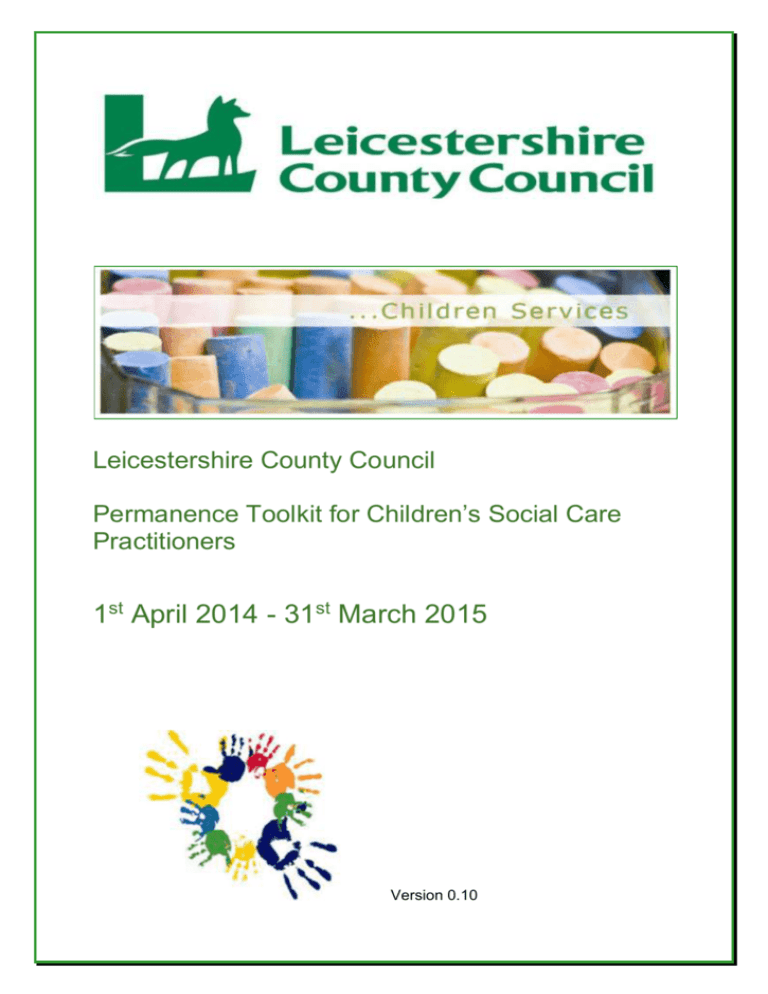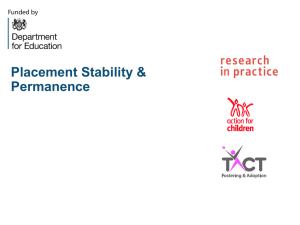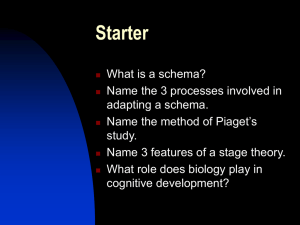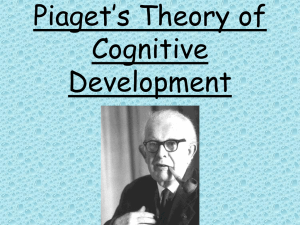Permanence Toolkit for Children`s Social Care Practitioners for
advertisement

Leicestershire County Council Permanence Toolkit for Children’s Social Care Practitioners 1st April 2014 - 31st March 2015 Version 0.10 Leicestershire County Council Toolkit for Permanence The Leicestershire Permanence Toolkit This Permanency Toolkit has been devised to accompany the Leicestershire County Council Permanence Strategy, Choices and Policy December 2013. The toolkit has been developed with practitioners and aims to provide: a) an information guide for agency partners, families and children. b) practical and useful aid when social care practitioners are planning for permanence with our children and families. The content of the toolkit is set out in 2 parts. Part A contains information and practical hints. Part B contains more detailed guidance for Social Care Practitioners in Children’s Social Care Services for assessing and planning for permanence Each part contains a series of leaflets. Part A: Information Leaflet 1 What is Permanence? Leaflet 2 Our principles Leaflet 3 Planning for permanence Leaflet 4 What we want to achieve for children and young people Leaflet 5 Options and support for permanence 5.1 Birth Family 5.2 Connected Persons 5.3 Permanent and long-term foster care 5.4 Adoption Part B: Practice Guidance Leaflet 6 Practice guidance principles Leaflet 7 Practice guidance for core assessment summary report in permanence planning Leaflet 8 Options for Permanence Leaflet 9 Life Story Practical exercises and resources Leaflet 10 The importance of Life Story work Leaflet 11 Little Books of Understanding Leicestershire County Council Toolkit for Permanence Part A: Information Leaflet 1: What is Permanence? What is ‘Permanence’? ‘Permanence’ is the word to describe what Leicestershire County Council are working hard to achieve for children and young people that are helped by Children’s Social Care Services. It is taken from Choices in the new Permanency Strategy and Permanency Policy1 the definition of Permanency states: The objective of planning for permanence is to ensure that children have a secure, stable and loving family to support them through childhood and beyond. What ‘Permanency’ means for children and young people? 1 Living with a family where they feel safe and a sense that they ‘belong’ Knowing and understanding about their past, present and where they are going Helping children to feel loved and have positive relationships Supporting them to achieve everything they can in school, with their health and their futures Leicestershire County Council Choices Strategies Dec 2013-2015 and Leicestershire County Council Permanency Policy July 2013-2015 Leicestershire County Council Toolkit for Permanence Leaflet 2: Our Principles There are a variety of ways that children and young people can live with a sense of ‘permanence’. We believe in our principles for each option and we will strive to make sure that all our work and practice is guided by these principles: For Children and Young People All children have the right to a family life, where possible with the birth family Where this is not possible, we will search for extended family and friends (‘Connected’ persons) Where a child needs to come into care, we will provide a safe and loving alternative family All decisions we make will respect the child’s ‘voice and choice’ All decisions we make will respect the child’s ethnic origin, culture, religion, language, identity and disability Every child and young person will receive the support they need Every child and young person will be helped to achieve the very best they can For Families Every effort will be made to enable, support and promote the child’s own birth family to provide a permanent home for the child where it is safe to do so Families will be supported by all the services working together Support for families will take into account and positively respect their identity (ethnicity, culture, religion, language, gender, sexuality and disability) The views of families will be listened to and considered in the development and shaping of services For Carers The carer will be recognised as a member of the team around the child and family/placement The role of the carer is paramount in helping the child to feel the sense of belonging, security and identity Leicestershire County Council Toolkit for Permanence Leaflet 3: Planning for Permanence The Pathway to Services document has been produced to help clarify the roles and responsibilities of Children's Social Care and Targeted Early Help services, aiming to encourage appropriate referral according to identification of need and service thresholds. The families referred to or seeking help from Children's Social Care will have differing levels of need. Many will be helped by advice or practical services or short term intervention. A smaller proportion will have problems of such complexity and seriousness that they require more detailed assessment, involving other agencies in that process, leading to appropriate plans and interventions. Social Care Services will conduct an assessment and write a report that will include: A full list of important events in the child’s family history (Chronology) Take into account any alternative options in the child’s birth family or connected persons Test whether it is safe for the child to live with their birth parents Seek the child’s ‘voice and choice’ and take these into account in the assessment Take into account the birth parents and connected persons views Take into account the views and assessments of other professionals and agencies Take into account the effect of any legal involvement Ensure that there is proper analysis of the assessment Make recommendations Do what they say they are going to do in the time that they say Review the plan in the time that they say And continue to assess and review the needs of the child Leicestershire County Council Toolkit for Permanence Leaflet 4: What we want to achieve for children and young people When we are planning for permanence for a child or young person, we always focus on what we are trying to achieve, or in other words what are the desired outcomes for the child during and after Social Care help. Safety and Welfare - Children are protected from abuse and neglect Children and young people feel safe Children and young people have improved emotional and mental health Stability of placement - Children live in caring and stable families. Children have a secure base which will help with development of belonging and identity Children stay in the same placement and have positive relationships maintained Children do not move placements if it is not necessary, but are included early in the decision making if they have to move placement. Children will be placed near to that local common if safe to do so, wherever possible Education and leisure activities - Improve educational outcomes for children with permanence placement Children and young people achieve in school and college Children and young people attend school and are not excluded Children and young people do fun activities Moving on Children and young people change placement or move on in a positive way Young people have access to education, employment and training Children and young people are encouraged to “stay put” Leicestershire County Council Toolkit for Permanence Leaflet 5: Options and Support for Permanence 5.1 Remain with/return to birth family Leicestershire County Council believes that all children have the right to experience family life, and that wherever it is ok with their health and welfare, this should be with their own families, their friends and communities. The child and the child’s family should have a voice/choice and be included in all early stages of considering alternative living arrangements. Where there are significant safeguarding concerns it is essential that wider family are engaged through Safety Meetings for Family and Friends using the Growing Safety approach to enable the extended family to carefully consider how it could exercise its responsibility in caring on a temporary (or permanent basis) for a child at risk. If the child is already in care, then this approach can be used for planning for permanency planning or going home. Support for living with birth family All forms of permanence require the right support at the right time for the child and family/carer based on assessed needs, effective planning and review. The Local Authority, in partnership with other agencies, to prevent children coming into care, will ensure that the right support is available for the child to return to live at home. The Strengthening Families Service deliver an assessed programme of support to help prevent disruption of a long term placement within the family network. The Family Safeguarding Service will link with Early Help Services to provide ‘edge of care’ support where required. Additional advice, guidance and information to birth families to access targeted or universal services is provided. Please refer to Leicester City, Leicestershire and Rutland Children and Young People's Service Procedures Manual links for further details: 1.18 http//llrchildcare.proceduresonline.com and 1.17 http//llrchildcare.proceduresonline.com Leicestershire County Council Toolkit for Permanence 5.2 Living with Connected Persons (Family and Friends Care) In some circumstances, children may not be cared for by their birth parents because it is not safe to do so, or because their parents are unable to look after them. Where this is the situation, either on a temporary or on a permanent basis, Leicestershire County Council will explore children and young people living with members of the extended family, wherever this is assessed as being consistent with their welfare. This should be informal arrangements where possible (not formal i.e. not Looked After). When alternative to care the Connected Persons (Family and Friends) arrangements can play a unique role in enabling children and young people to remain with people they know. The majority of relatives who provide care are grandparents, aunts and uncles or sometimes older siblings. Where children cannot be cared for within their own extended family, Leicestershire County Council will then find out if there are any friends with whom it would be appropriate for the child to stay. In support of the aim to return children to their parents or families wherever possible, there will be a plan to maintain contact between children, parents, and other important relatives. Planning for children includes a responsibility to discuss plans with them and establish their ‘voice and choice’, as well as making a judgement about their needs. For further information on the types of Connected Persons care arrangements: Please refer to Leicester City, Leicestershire and Rutland Children and Young People's Service Procedures Manual links for further details: Informal family arrangements 2.1.1 and 2.1.2 http//llrchildcare.proceduresonline.com Private Fostering 1.5.1 http//llrchildcare.proceduresonline.com Living with Connected Persons on a Residence Order (Private and Public Law) 1.1.7 / 3.9.8 http//llrchildcare.proceduresonline.com Living with Connected Persons on a Special Guardianship Order (Private or Public Law) 4.2.2 http//llrchildcare.proceduresonline.com Leicestershire County Council Toolkit for Permanence 5.3 Permanent Foster Care and Long-Term Foster Care Where a relative or family friend (Connected Persons carer) does not come forward to permanently care for a child the process of ‘family finding’ for foster care needs to be undertaken. This is a joint activity between those professionals responsible for the child and those responsible for assessing and approving carers. Finding permanent or long-term carers for looked after children is a key role of the Local Authority. For all types of carer the Local Authority must assess, train, approve, supervise and support carers and they must be annually reviewed against Fostering National Minimum Standards. All potential foster carers have to be recommended by a statutory panel, legally constituted with a proportion of independent members and approved by the Agency Decision Maker. Children and young people need to be prepared for a new family. This will always include help in understanding and collecting information about their ‘life story’ and may involve some therapeutic work in helping to deal with the loss of their birth family and support the transition to a new family. Please refer to Leicester City, Leicestershire and Rutland Children and Young People's Service Procedures Manual links for further details: Support to Foster Carers 3.2.11 and 3.9.5 http//llrchildcare.proceduresonline.com Support to Disabled Children 2.2.1 http//llrchildcare.proceduresonline.com Leicestershire County Council Toolkit for Permanence 5.4 Adoption Adoption remains the most legally secure permanence option, often for younger- aged children, who cannot remain with their parents. All parental rights and responsibilities for a child are permanently transferred to an adoptive parent by a court order. As a result, the child legally becomes part of an adoptive family. Adoption plans will need to identify all relevant time scales throughout the process. Birth parents will be offered the support of another social worker who is independent of the team who are planning for the child. All children looked after for whom adoption is the plan will have a named social worker who will work with them through the planning and placement process up until the time that the Adoption Order is made. Information about the adoption process, including written information, will be given to the child by the child’s allocated social worker. Where a prospective adoptive family is identified, they will be provided with full social, medical, and legal information about the child and his/her circumstances, in order that they might reach an informed decision about whether or not they feel able to parent the child appropriately. Adopters will be provided with advice and training on how to keep relevant information about their adopted child safe, and how to share it appropriately in due course. The child’s social worker will ensure that life story work is done with the child to prepare him or her for a new placement. This may be done by the child’s social worker or by another suitable worker or carer. Please refer to Leicester City, Leicestershire and Rutland Children and Young People's Service Procedures Manual links for further details: Adoption Support 4.1.5 http//llrchildcare.proceduresonline.com Leicestershire County Council Toolkit for Permanence Part B Practice Guidance Leaflet 6: Practice guidance for permanence planning Key practice principles Children should be brought up within their own families where this is safe. If a child is Looked After by the Local Authority, reunification with birth family will always be considered where this is safe and in the best interests of the child Where this is not possible, the Local Authority is committed to seeking alternative permanent carers. The Local Authority is committed to working in partnership with birth families, carers, and other agencies involved in providing services to the child, to ensure the child’s needs are met, and a plan for permanence can succeed Permanence planning for a child must be timely, purposeful, realistic, and safe. Plans will be based on the care the child has received, their needs, and the care they are likely to need throughout their childhood and the ability of any carers to meet these needs Permanence planning must take into account the views and wishes of the birth family, the child, and their attachments with parents, siblings and any other significant person. Permanence planning must always take into account the child’s cultural background, ethnic origin, religion, gender, sexuality and their needs arising from any disability. Permanence planning for a child who is Looked After must be made within the current legal framework and guidance The reasons for all decisions and recommendations from a child’s Looked After Review in relation to permanence planning must be fully recorded, along with the views of the child, birth parents, siblings, carers, key-worker and any other relevant person If going home is not possible, the Local Authority will work in partnership with birth parents in planning for an alternative permanent family for a child. When it is not possible to do so by voluntary agreement with the family then the Local Authority has a duty to invoke statutory procedures, if the legal criteria are met A child must only remain Looked After to effect a plan for permanence when all other options have been explored and it is deemed to be the only plan that can safely meet the needs of the child. The reasons must be recorded on the child’s Care Plan Any permanence plan for a child who remains Looked After is subject to regular Reviews. This is part of an ongoing process to ensure the child’s Care Plan meets their changing needs. Consideration will be given regarding alternatives to the child remaining Looked After, and whether it is in the child’s long-term, as well as current interests. The Review of Arrangements must record that this has been considered and reasons for any proposed changes/rejection of any alternatives, at each Review. Leicestershire County Council Toolkit for Permanence The right language of expression frees a child the wrong language imprisons him. Leicestershire County Council Toolkit for Permanence Leaflet 7 Practice Guidance for Single Assessment Summary Report in Permanence Planning 7.1. The child’s welfare is paramount In order to ensure this, we have to demonstrate an understanding of what has happened to the child and what this means for the child. A full chronology is required of the child’s family history (significant events). Analysis is essential to understand their past and to make plans for their future. Evaluation and analysis must be undertaken using The Welfare Checklist (Children Act 1989), The Framework for Assessment and guidance on Core Assessments and must take account of: The actual and potential risks of harm to the child; The needs of the child (including relating to any disability); The child’s age, sex, background, culture, ethnicity, religion, language; The ‘voice and choice’ of the child; The ‘voice and choice’ of the child’s birth family; Likely effect of any change in circumstances; The capacity of the birth family to address risk and meet needs identified. If some of this information is not yet available from existing files/reports or contact with the family and other relevant people, then give an indication of when it will be available. Consider whether additional information, support or services are needed to fully take into account the culture, ethnicity, religion, language, nature of any disability or sexuality – for example, interpreter, communication specialist, aids/tools, referral to other service. 7.2 Children should live with their birth families where it is safe and practical to do so It should always be the priority to try to reunify children with their families through Safety meetings and Growing Safety approach: It must be established that this is safe for the child. Where it is safe, all options should be explored to enable and support families to exercise their Parental Responsibility to care for their children. Where it is not safe, or where parents are unwilling or unable to meet the assessed needs of the child, all options should be explored to enable parents to exercise their Parental Responsibility to recognise risk, protect their children and meet their essential needs. This needs to be within a timescale that does not significantly impair the development or opportunity for secure and stable attachments for the child. In analysing information gathered and observations, consider the following: What changes are needed to enable the child to return/remain at home? Can these changes be made within a timescale that will not significantly impair or inhibit the child’s development and opportunity for secure and stable attachments? Is there the potential for change at a later time? Identify a timescale. What resources may be needed to enable changes to take place and be sustained? Take into account research and evidence relating to the birth parents/carers’ ability and motivation to make any changes identified and sustain them. Leicestershire County Council Toolkit for Permanence 7.3 The Child’s ‘voice and choice’ should be taken into account Children will have a life-long longing to be recognised, valued and loved by birth parents and will want to go home to achieve this. This fundamental need can hinder them embracing a new family, or the prospect of a new family. When the birth family are unlikely to be able to give the child this love and recognition they crave, returning home will not meet the child’s emotional needs. A child’s fear that the parent will not survive if the child is not there can also influence their reported wishes, especially where the child has had too much responsibility and had been in the position of caring for the parent. Be aware of possible development of “Trauma bonds”. This is an outcome of the dilemma for the child where the source of fear and the source of care and comfort are found within the same attachment figure. The attachment relationship contributes to perpetuating the abusive relationship. The child clings to the relationship - fear of further abuse heightens the attachment need - leading to stronger desire to return/remain with the parent as attachment figure. Children’s wishes should be discussed with them to gain their verbal comments or through direct work on their past, present and future. These need to be noted and considered in light of the child’s understanding of their past. Consider the child’s emotional level of development. How does this affect their ability to understand? Analysis and observation of the child in differing situations such as contact visits (pre, post, during) with other adults, other children, different social situations or one-to-one occasions is essential Make sure you are effectively communicating with the child and understanding what they communicate to you. Consider what aids or tools you might need if the child has a disability affecting their hearing, sight or language skills. Take account of any learning disability or mental impairment. Take account of the child’s cultural background. If English is not the child’s first language, consider whether an interpreter is needed. The interpreter must be suitably trained and qualified and approved through the County Council. Consider the observations of other relevant people in the life of the child: Who knows the child best to give their view; Other people/professions may have useful comments on the child’s wishes, i.e., teachers, foster carers, contact supervisors It is less threatening for a child to express feelings through play and games, and imagination for older children. It enables a child to share emotions and thoughts especially if they have underdeveloped or limited verbal and conceptual skills or are wary of sharing their thoughts with adults. Life-story work is an ongoing medium for working with children to give and gain an understanding of their life. It can give focus for visits to a child by their worker and can include their parent and/or carer. It should begin in this early assessment stage though is likely to be ongoing. Over time, it will be possible to achieve a chronological narrative of important events and emotional development and expression. Leicestershire County Council Toolkit for Permanence 7.4 Take in to account the views of birth parent and other significant Connected Persons (including siblings) Ensure the views of birth parents and other significant people are included. Record the birth parents’ views relating to the child’s religion, culture and ethnicity. Identify who has Parental Responsibility. Include the views of siblings and the implications for them of any proposed plan for permanence. If the permanence plan recommends that the child be placed away from their birth family, consider the strength and nature of attachments to siblings and other relative such as grandparents. Do the needs of the child indicate that they ought to be placed with siblings or separately? Are all the children in the family to be cared for away from the birth family? Will the attachment to siblings, birth parents or other significant person inhibit future attachments to others? Consider the life-long benefits of attachments and contact with siblings, birth parents or other relatives? Consider the wishes and views of birth parents, siblings or other relative - would they enable the child to form new attachments? Would they be able to commit to contact arrangements without jeopardising the future safety, stability and security of the child? In respect of siblings, what are their needs and wishes? Are they compatible? The assessment of whether siblings should be placed separately or together, and the level and nature of contact is complex and should not be underestimated. It is essential for workers to incorporate this aspect of permanence planning into their Single Assessment Summary Report from the outset. The needs of the child may indicate that they will need a great deal of individual time and attention from a future carer. They may display challenging behaviour. They may have difficulty forming and sustaining attachments in the future. They may be at risk from the behaviour of a sibling. These are all factors to be taken into account when assessing whether it will be possible for a child to be placed with siblings. The nature of the relationship and attachments between siblings should be assessed in the light of their past shared experiences, nature of their respective parental attachments, their present ‘voice and choice’ and their age and relative stage of development. Remember that the needs of the child in respect of contact with their birth family may change over time. The ability and willingness of the birth family may also change. They may need assistance and support to overcome feelings of anger, guilt and loss before they are able to commit to contact arrangements without undermining, wittingly or unwittingly, the child’s new placement. Leicestershire County Council Toolkit for Permanence 7.5 Take into account the views and assessments of other relevant professionals These must be included in the SIngle Assessment Summary Report for permanence planning in order to inform decision-making. The nature of other professional or agency involvement must be made explicit. Any information or assessment by another professional that may be required to complete an assessment should be identified, for example, psychological/ psychiatric assessment of a parent, with reasons as to why this is necessary. 7.6 Take into account any alternative options within the child’s birth family Exploration of any relatives or friends of the child/child’s family who express a desire or whom the child/family/yourself identifies as a potential alternative permanent carer. Relatives or friends may enable a child to remain with their extended family, community or culture. Identification of any additional support/further assessment or approval that may be required. Exploration of all legal options to enable a permanence plan with relative/friend carers to be effective and safeguard the child. 7.7 Take into account the likely effect and purpose of any legal intervention Exploration of all legal options and their possible effect/ability to progress a plan for permanence. Legal advice is essential to inform decision-making. Analysis of the merits/disadvantages for the child and their birth family of any legal intervention based on the principle of the Children Act, 1989, that any legal order must be better for the child than no Order at all. Consideration of options to enable the prospective permanent carer of the child to share Parental Responsibility - Residence Order, Special Guardianship and Adoption. Consideration of the use of a Supervision Order rather than a Care Order if a child’s needs may be met by the birth family with some level of safeguarding required by the Local Authority. Effect of timescale for any legal intervention on permanence planning - including timescale for obtaining any Order affecting the proposed permanence plan, and length of time such an order may be required for. Leicestershire County Council Toolkit for Permanence 7.8 Ensure that there is proper analysis of your assessment This should include: Exploration of available “permanent” care options (birth family, significant connected persons, Permanent/long-term foster carer, Residence Order, Special Guardianship Order, Adoptive parent Indication of nature of attachment to birth family - parents, siblings, significant other (secure/insecure, avoidant, ambivalent). This should include exploration of any shortterm and long-term effect of any separation/loss and likely benefit/adverse effect of ongoing contact, should the child be separated from their birth parents, siblings or significant others Nature and likelihood of risk of significant harm in each option considered - emotional, physical, sexual, neglectful and likely short-term and long-term effect of this harm for the child. Likelihood of birth parent/other significant carer changing, if change is identified, in order to prevent significant harm and meet the child’s needs within a timescale that does not create further significant harm to the child Likelihood of alternative permanent carers meeting the needs of the child or preventing future significant harm Likelihood of any proposed plans being achieved within a timescale that does not create further significant harm to a child. ‘voice and choice’ of the child, parent, siblings, carer, and significant other Likelihood of the need for legal action in private or public law, the effect of this on the plan for permanence, and the implications of this for the child and birth family. 7.9 Make Recommendations A Single Assessment Summary Report being presented to a Review of Arrangements meeting for Review for permanence planning must contain a proposed permanence plan. These proposals must be shared with the child and family prior to the Review. Outline the proposed plan(s).How will the proposed plan be achieved? Any areas where more information or further assessment is needed. proposed timescale? What is the What needs have been identified that have to be addressed to affect this plan? What additional support/resources can be identified to address these needs? What are the alternatives should this plan not be achieved or fail, and how could they be progressed to avoid delay? Identify whether a contingency or parallel plan is required. The reasons why this may be needed should be shared with the child and the family and timescales considered. Identify any legal intervention that may be required. Leicestershire County Council Toolkit for Permanence 7.10 Ensure plans are actioned in a timely manner The timescales should be adhered to: They are linked to the Adoption and Children Act 2002 guidance and the Public Law Outline; They ensure the child’s needs remain paramount; They enable better partnership working with birth parents and the wider family. 7.11 Ensure plans are reviewed in a timely manner If there is a contingency or parallel plan, ensure timescales are made to review the main plan. The need of the child to be safe from significant harm and for their welfare to be paramount throughout their life should be the priority when making decisions about when to move on to the contingency or parallel plan. Plans for reunification with the child’s birth family should keep to the timescale recommended in the Core Assessment Summary Report and subsequent Review, and not be allowed to ‘drift’. Sometimes there can be reluctance, or resistance, to testing reunification. This may be because a potential new risk to the child has emerged or there is concern that previous risks remain. An ongoing assessment of risk and the needs of the child is essential to ensure any delay to planned reunification is evidence based, purposeful and in the best interests of the child. If the needs and risk assessment indicate a plan for reunification cannot safeguard the child or meet their needs, then the parallel or contingency plan recommended in the child’s Care Plan must be actioned. If there is no agreed contingency or parallel plan, the Review must be reconvened without delay to consider other permanence options. Sometimes reluctance or resistance to a plan for reunification arises because of fear that the child’s short-term stability and progress will be adversely affected or because there is a reluctance to deal with painful or difficult issues. This must be balanced against the evidence indicating that a child’s long-term need for security, stability and support through to adulthood is more likely to be met within their own birth family and community. A child should not remain Looked After because of a lack of commitment or action to progress a plan for reunification. Leicestershire County Council Toolkit for Permanence 7.12 Continue to assess the lifelong needs of the child Care planning is a ‘journey’ and not a finite event. The permanence plan assessed and approved for the child may be for the child to remain Looked After throughout their childhood. If this is the case, the Local Authority has a duty to review the Care Plan for the child at least six-monthly. The child’s Social Worker should monitor the Care Plan to ensure this continues to meet the long-term needs of the child. The Social Worker should be making an ongoing assessment of whether any significant changes have occurred since the last Review or are likely to in the near future. The Social Worker should look at how the birth parents, child or long-term carer could be enabled to make any changes needed to better meet the child’s long-term needs. Changes to the child’s Care Plan may indicate a change of placement, or other changes to meet the needs of the child throughout their life, for example changes to contact arrangements or legal status. In some situations, a reassessment of potential for reunification with a birth parent or family friend or relative may need to be considered. If so, options in respect of changes to the child’s Care Plan should be discussed with the child, birth parents and carer at the time they emerge and definitely prior to the Review. Any potential or actual changes must show evidence of being capable of being sustained. They must show evidence of being in the child’s best interests and demonstrate that the child’s life long welfare remains paramount. Any support needed must be identified. It is important for the child to know that their long-term foster placement will be their home, whilst this is still their Care Plan and best meets their long-term needs. You will need to be sensitive to the conflicts, fears and feelings of insecurity this process may evoke in the child, the carers and the birth family. They will all need reassurance that change will only happen if there is evidence to indicate that an alternative plan will better meet the long-term needs of the child. Ongoing communication and consultation will be needed between the Social Worker, carer, child and family and other relevant professionals if there is evidence to indicate that an alternative plan can be considered. This should happen as part of a process before, during and after the child’s Review. Any new plan may involve some shorter-term risks. These should be balanced with evidence of what each participant can contribute to reduce any potential risk to the child’s welfare. It is important to keep the focus on what can meet the life-long needs of the child. Leicestershire County Council Toolkit for Permanence Leaflet 8: Options for permanence Always consider all the options Remain with/return to birth family The Children Act 1989 requires that all reasonable efforts are made to ensure children remain with or return to the care of a birth parent whenever possible. Planning for reunification will need to reflect the legal status of the child. Children who were Looked After under S.20 of The Children Act 1989 may require support as ‘children in need’. The Local Authority continues to share parental responsibility for children who are the subject of Care Orders. The Placement with Parents etc. Regulations will apply, as will the need for regular Reviews of Arrangements. Connected Persons Care (Family and Friends carers) Where a child cannot live with their birth parents, the preferred option under The Children Act 1989 is to seek a home for them with their extended family, where this is consistent with their welfare. Existing positive relationships will contribute to provide the continuity that a child needs. Permanent or long term foster care Fostering can provide a supportive relationship and adult attachment for a child but can also allow attachments to parents and the child’s wider family to continue, where this has been assessed to best meet the child’s life-long needs. Where the carer has been assessed as able to meet the child’s need for secure attachments for the remainder of their childhood, fostering is an important permanence option for some Looked After children. Residence Order (RO) A Residence Order to a parent, relative or friend or foster carer must be considered as an option in permanence planning, for a child who is or is about to be looked after. A RO establishes day-to-day living arrangements for the child/young person. Parental responsibility (PR) is shared equally between parents and RO holder, PR is acquired once the order is made. The child does not necessarily live all the time with the person with the RO. The RO will last until the child reaches 18 years old unless revoked by the Court. Support services are at the discretion of the LA, any child in need living in the community can be offered support. A report by a Social Worker may be requested by the Court. Special Guardianship (SG) A Special Guardianship order to a relative, friend, or foster carer (but not a parent) must always be considered as an option in permanence planning for a child who is or may be looked after. Applicants must be over 18 years old. A special guardian may exercise PR to the exclusion of all others with PR except for another SG, unless the consent of more than one person is required e.g. child sterilization, or adoption. The Local Authority is required to make arrangements for the provision of SG support services, which includes counselling, advice and information and other services including financial support, which can be ongoing. The provisions identify the right to an assessment. Adoption Adoption can offer children who are unable to return to their birth families a legally permanent new family to which they will belong all their lives. Adoption is therefore an important means of securing permanence for children. Residential care For a few children, a placement within a residential setting until independence will be the placement option that best meets their needs. Where this is the identified aim of the child’s agreed Care Plan, the plan must address how the child’s need for secure attachment to significant adults will be achieved and supported. Leicestershire County Council Toolkit for Permanence Leaflet 9 The importance of Life Story work Life Story work helps children separated from birth families make sense of their past experiences. Some children may be too young to remember or understand what has happened in their lives. Children in care often experience many changes and as a result, information about their past and heritage can get lost or forgotten. Life story work can take the form of a book, scrap book, photo album, interactive CD, collection of personal items, memory box. The following Flow Chart demonstrates the multiple points in time where information of value to Life Story Work can be accessed and recorded for future use. Initial Child Protection Conference FSS/Strengthening Families/IRO Social Care Midwife Outcome Child Protection Plan Health Visitor Police Probation Initiates Life Story Work: Initiates Direct Work with Child Core Group Meeting Pre-Birth Assessment School Extended Family Parenting Assessment Life Story Box Parents Pre Birth Planning Meeting Social Care Initiates Involvement from: Information Sharing Meeting Midwife Health Visitor Police Parental/Kinship/ Foster Carers Birth Probation Giving Access To: Parents School Gaining Access to: Discharge Meeting Red Book PAM Link Book Photos Extended Family Giving access to: Initiates Leicestershire County Council Toolkit for Permanence Contact: Photos (Weekly/Monthly) Contact Records/Observations Scrapbook Next Step Programme of words and picture boards with birth parents Family Members Birth Records Criminal/Victim History Family Health Records Educational Records 28 Day Review Life Appreciation Day: Legal Planning Meeting Social Care Health/Police Education Twin Tracking Please remember: Life Story work and the Later Life letter should be presented in draft to the Matching Panel and given in draft to the Adopters no later than before the second review in the placement - this date that the draft is given to the adopters needs to be recorded and monitored by the Independent Reviewing Officer (IRO). The Final Life Story Work and later life letter should be given to the adopters no later than 10 days after the adoption ceremony and again the date the final work is given to the adopters needs to be recorded and monitored by the IRO. Leicestershire County Council Toolkit for Permanence Leaflet 9 Life Story Practical Exercises and Resources 9.2 Practical exercises Click on the attachments to find printable practical exercises to work on life story work with children and families A week in my life.doc Contact with my birth family.doc Me and my body.doc Happy thoughts and feelings.doc Imagine.doc My birth family.doc My birth place and My family now.doc where I live now.doc My thoughts and feelings.doc Special memories.doc Star Light.doc The future.doc Maps and moves.doc My schools.doc Things I know about myself.doc Words and Picture.doc 9.3 Resources for life story work British Association of Adoption and Fostering http://www.baaf.org.uk/ www.baaf.org.uk/bookshop/book_Digital_life_story_work The Fostering Network http://www.fostering.net/ Words and Picture Boards Little books of Understanding Leicestershire County Council Toolkit for Permanence Action Helping the children make their own list of what a parent should do Thinking behind the action Exploring the needs of a baby and why they need these things allowed the children to think about how their own needs have changed as they’re grown up. The children were then ready to compile their own lists of their needs Leicestershire County Council Toolkit for Permanence Action Produce a ‘Thought Cloud’ Thinking behind the Action This is useful if you are working with more than one child, adding each child’s thoughts with a different colour. It pools their knowledge, supports their thinking, and confirms to them that their siblings are expressing themselves in the same way Leicestershire County Council Toolkit for Permanence Action Each child had a large square piece of paper. I asked them to choose from the ‘Thought Cloud’ what they wanted to draw. Thinking behind the action Talking about things is not always the easiest way for a child to communicate. Giving them guidance in this task allows a different way of identifying the gaps in their care. Leicestershire County Council Toolkit for Permanence Action I put each child’s drawings together in laminated booklets for them to keep Thinking behind the action The children have a view of their Mum and Dad loving them and don’t understand why they are not able to live with them. The booklets help them understand why people have been concerned and to make sense of their situation. Leicestershire County Council Toolkit for Permanence Leaflet 10 Little Books of Understanding How can a child tell you in everyday language how they feel, when their natural language for feeling is one of story, play and imagination Leicestershire County Council Toolkit for Permanence The aim of producing these books was to help the children realise for themselves and therefore understand what the care from a loving, responsible parent looks and feels like and how the lack of these things can affect them








